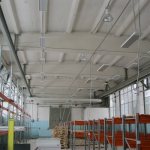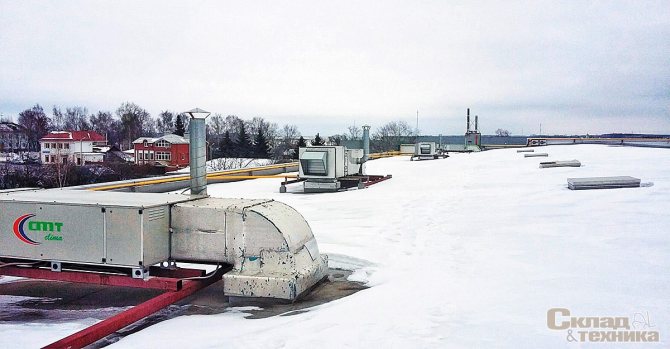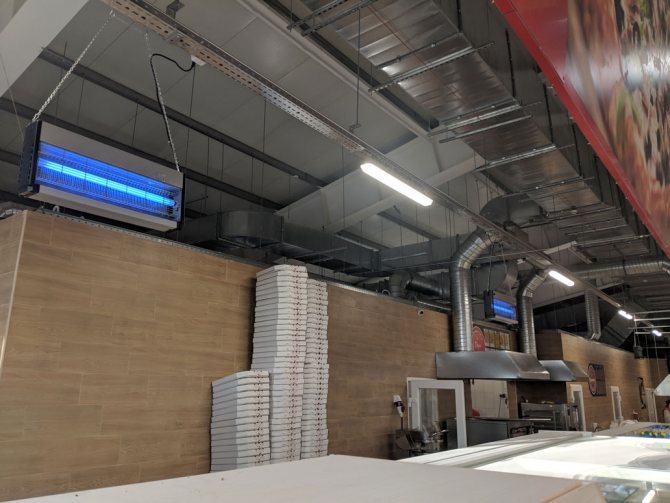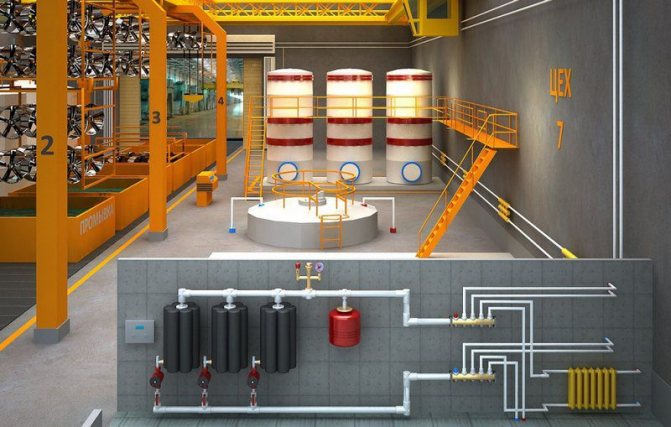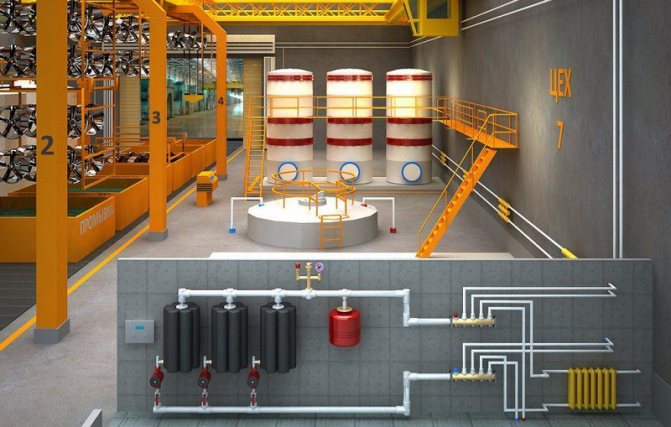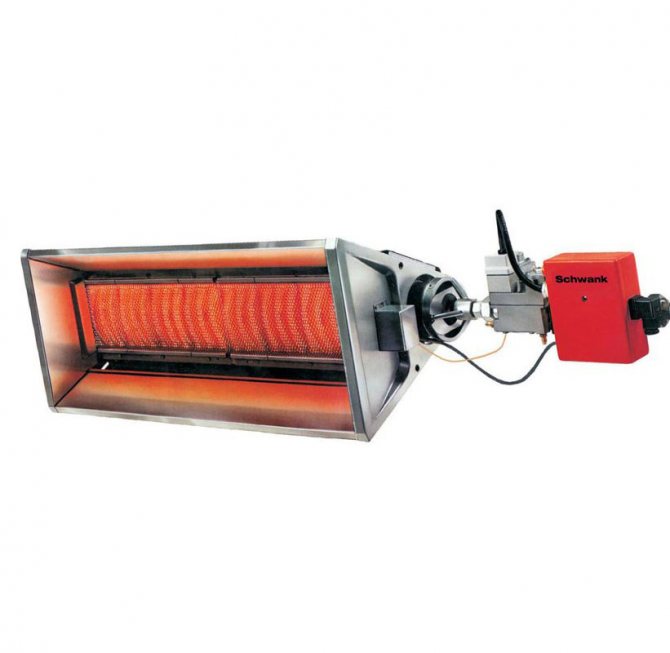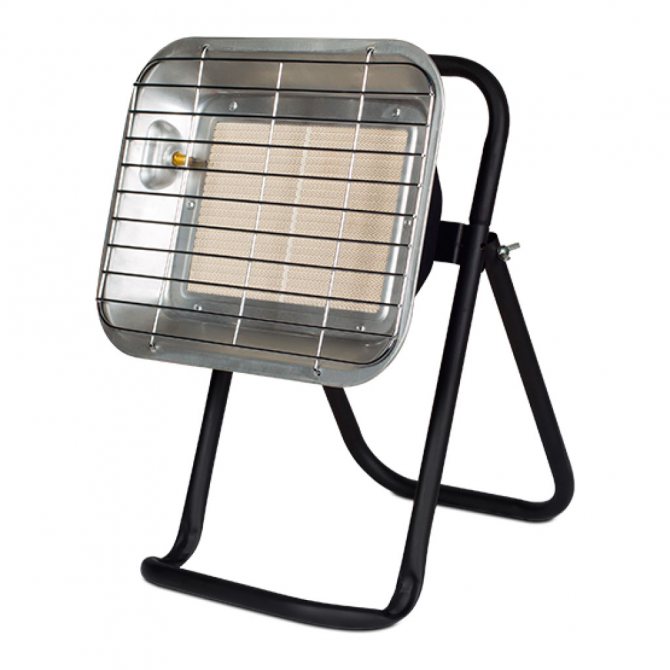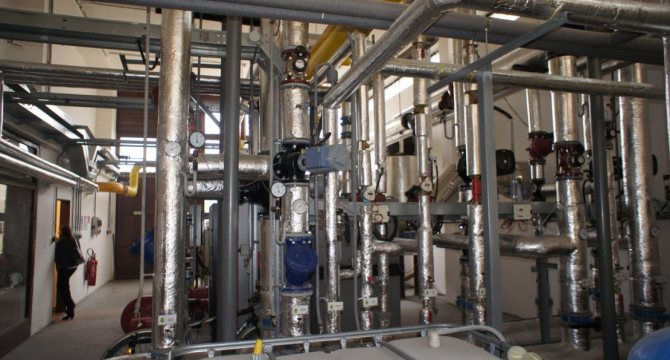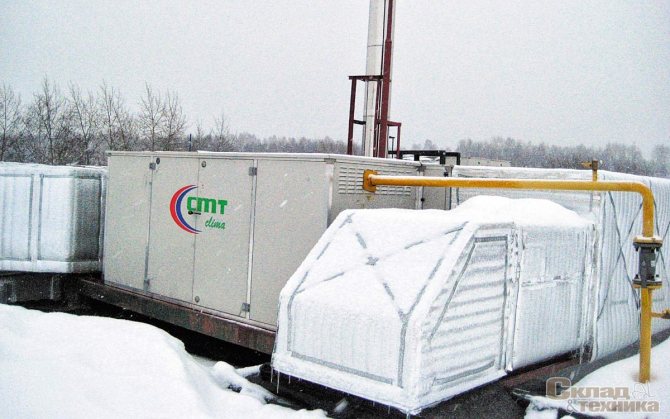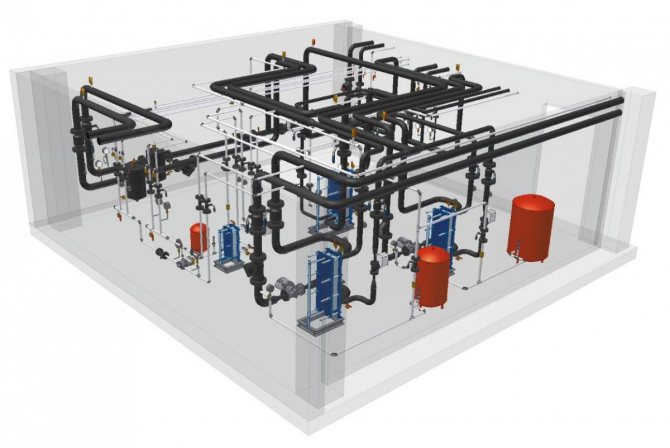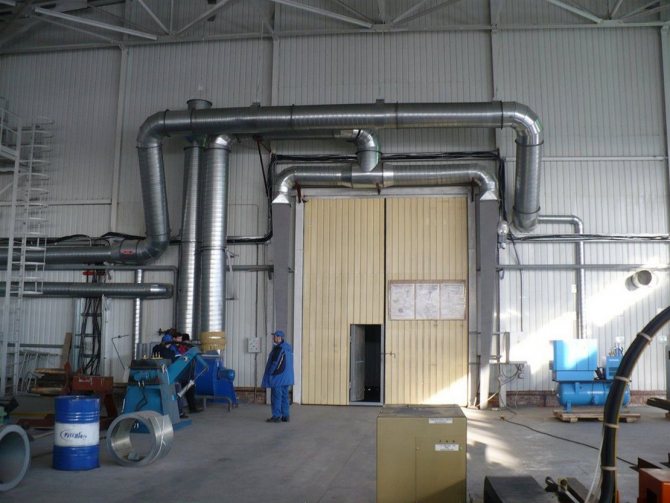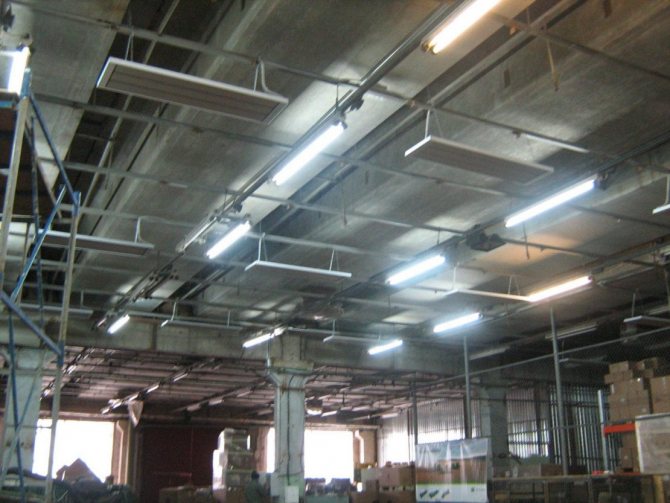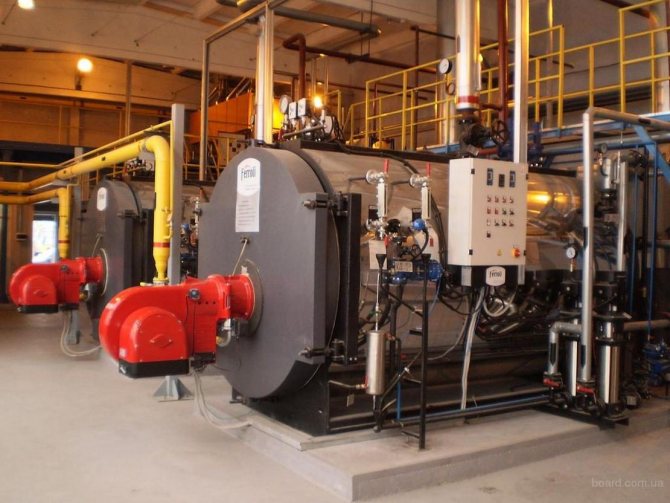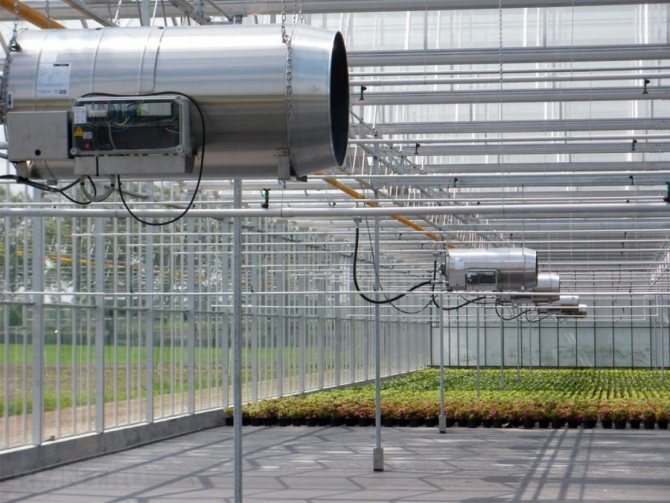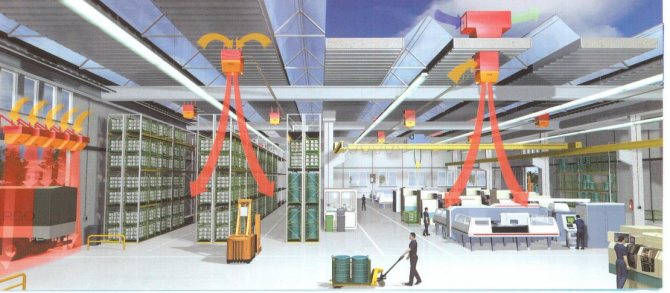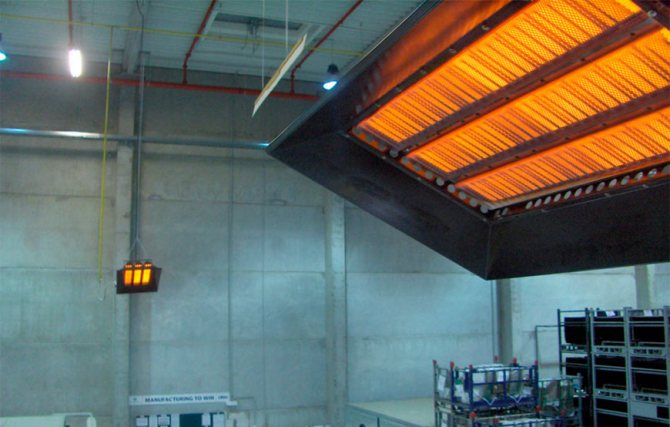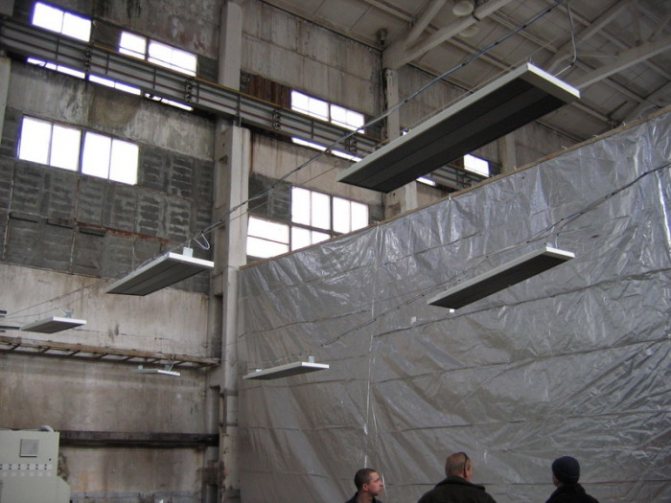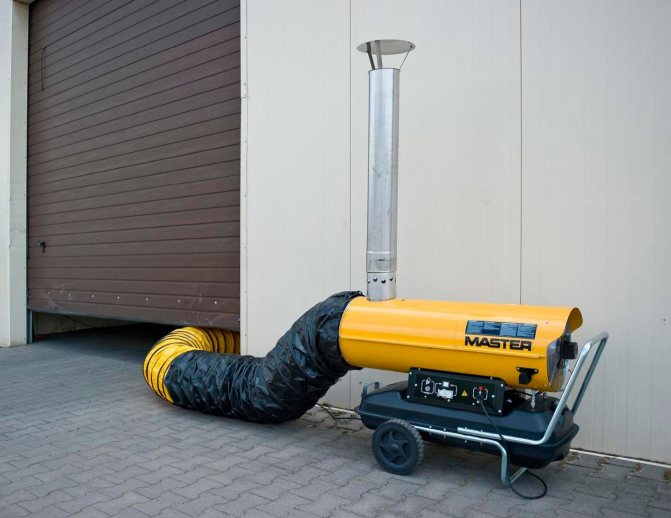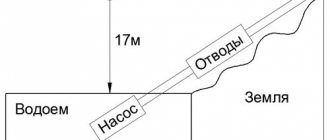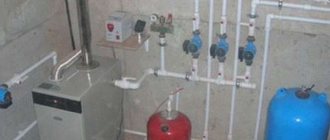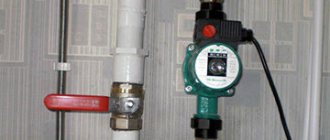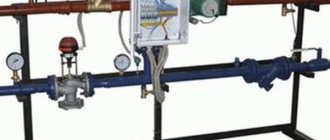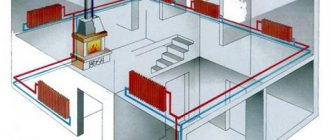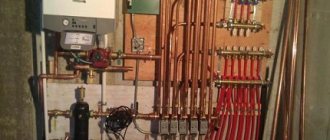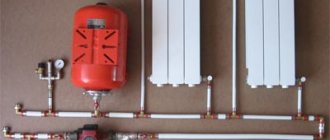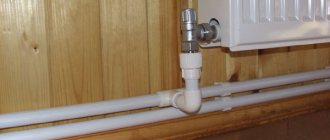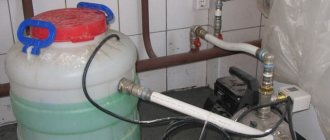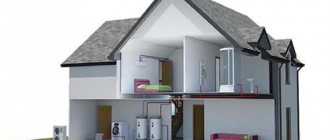A heating system is a complex of technical elements for generating heat, transferring it and transferring it to all heated rooms. Heating can be local or central. In the first case, the heating equipment and the pipeline are structurally combined into one device and installed in a heated room. Local heating is not quite suitable for warehouses due to the specifics of the terminals themselves.
Here, the central system will be optimal, in which the boiler or heat generator is placed in a separate room. When drawing up a warehouse heating project, special attention is paid to the calculation of the fire hazard category and the location of the main equipment. All instruments must be accessible for maintenance and repair.
Organization of thermal protection of the house
In places where heating will be done in the basement of a private house, it is necessary to insulate the outer walls, especially parts that will be in direct contact with the ground. This will help keep the interior warm and prevent condensation from forming.
In basements without heating, insulation with heat-shielding materials is made, as for a heated one, only additional layers can be added in the ceiling of the room in addition to prevent the penetration of cold into the upper floors.
With external thermal insulation, the basement gains the following benefits:
- There are no cold bridges through which the wind and frosty air enters the room;
- When condensation forms, it does not have time to inflict a destructive effect on materials and the room;
- The usable space inside the basement does not get smaller;
- It is convenient to inspect the structures, which allows you to notice in time their damage by fungus or mold, as well as defects due to harm from insects and rodents.
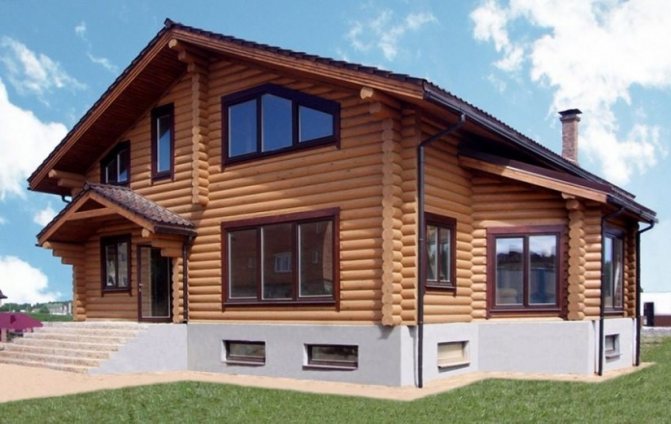
Among the shortcomings, it should be noted:
- It is necessary to protect the layers of thermal insulation from damage to the mechanical properties for the period of the entire use of the house, at the cost of protective devices significantly higher than the layers of the thermal insulation material themselves;
- It is difficult to protect against damage from the actions of insects, pest control is done with poisons and other toxic substances, which is not always applicable in a residential building;
- When facing with bricks, cold penetration is possible, which will reduce the degree of heat in the room.
Even during the design of the structure, protective work is planned against the following factors:
- The impact of groundwater, which, when it enters the basement, is difficult to dry, especially in terms of the enclosing structures;
- Moisture in the concrete mix during pouring for a long time enters the room, imparting dampness and a musty smell;
- Capillary rise of water from different sources through capillaries in the materials from which the basement was built is possible;
- The air of the room also forms moisture through condensation, the inner layer of thermal insulation is not able to ensure absolute tightness, therefore condensation can appear on the walls of the basement. It is also formed from gases from the soil, which can penetrate the entire perimeter of the basement;
- For internal insulation of a room, materials are often used, the level of water penetration of which is quite high, and when wet, their characteristics decrease. Then it is necessary to protect them with individual waterproofing works;
- Internal thermal insulation layers make it difficult to drain the basement. Moisture from soil, concrete and capillary water from base materials is very difficult to remove and requires long drying. It is required to make high-quality waterproofing;
- Walls that are below ground level are cold, and the warm and humid air of the basement somehow affects them from the inside, which leads to the formation of moisture with the subsequent destruction of materials.
When equipping a structure that protects against damage, additional layers of thermal protection can be made, both outside and inside. But they have the same drawbacks as the base, only they increase the estimate significantly.
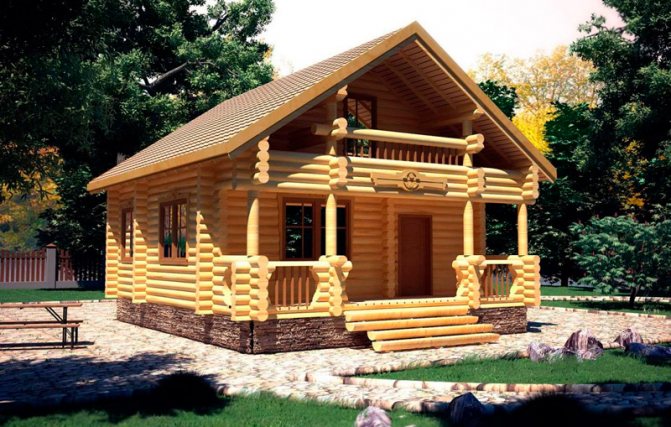

Payment for heating the rented basement
The amount indicated is determined on the basis of an invoice issued by the landlord with copies of utility bills attached. When using the second method the variable part, i.e. the cost of utilities can change every month depending on changes in tariffs or the amount of services consumed, which excludes economic losses for both the lessor and the tenant. At the same time, the provisions of clause 3 of Art. 614 of the Civil Code of the Russian Federation on the inadmissibility of revising the rent more often than once a year are not violated (for additional information, see clause 11 of the Information Letter of the Presidium of the Supreme Arbitration Court of the Russian Federation of January 11, 2002 N 66). 33.1.2.
Convection heating system registers, radiators or convectors
Heating devices in such a system are radiators, convectors or registers made of smooth steel pipes.
Advantages: the ability to create an electrically independent heating system; relatively low price of equipment and materials.
Disadvantages: extremely low efficiency of the system due to the fact that warm air from the registers immediately rises up, and not down, and leaves the working area; heating equipment takes up a lot of space on the surfaces of walls and floors, thus, the usable area of the room is reduced and used irrationally; high system inertia (large volume of heated water in pipes); the location of the heating devices at the bottom can lead to their accidental damage in the course of economic activity; with poorly performed commissioning, the system is poorly regulated; extremely low aesthetics of the register system, which does not meet modern requirements; the possibility of injury and burns in direct contact with the register surface.
Considering all the above facts, we can conclude that radiators or registers are advisable to be used only for heating low-rise rooms (with ceilings up to 3 m high). Otherwise, the running costs will be significant.
Air heating system using stationary gas air heaters
Air heating using gas air heaters is carried out by means of air (recirculation and / or supply air). It is fed into the unit with the help of a fan, after which it is heated and supplied to the room either directly or through a duct system, passing around the combustion chamber and through a heat exchanger, and the combustion products are removed through the chimney.
Advantages: the ability to use relatively inexpensive natural gas; the air duct system allows for the highest quality air mixing in order to reduce the temperature gradient and deliver it to the desired area; the heating, ventilation and air conditioning system based on indirect gas air heaters can also be decentralized (from the boiler room); the possibility of combining heating, ventilation and air conditioning in one system, due to which it is possible to achieve low metal consumption; greater efficiency and economy due to the absence of an intermediate heat carrier - water, which excludes the possibility of "defrosting" and leakage; low inertia of the system (air heating occurs in 20–40 minutes) and, as a result, a rapid change in temperature during the day; the possibility of placement inside the heated volume without preparing a separate room (boiler room); does not burn oxygen in the room; there are no attachments in the heated rooms; no harmful and toxic emissions in the premises; no heat transfer pipelines or additional cable systems.
Disadvantages: in the case of using main natural gas, heating will require a complex and branched gas supply system, which is extremely expensive both in installation and in design.
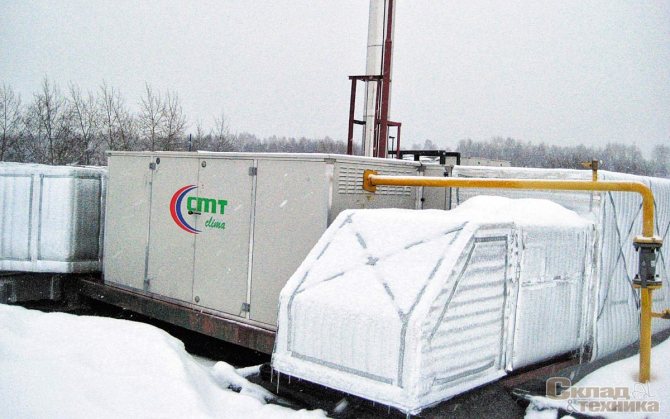

Air heating
Despite the good characteristics of the liquid heating system, air heating is also in good demand in the market. Why is this happening?
This type of heating system has positive qualities that allow you to appreciate such heating systems for industrial premises at their true worth:
- lack of piping and radiators, instead of which air ducts are installed, which reduces the cost of installation;
- increased efficiency due to more competent and even distribution of air throughout the room;
- The air heating system can be connected to ventilation and air conditioning systems, which makes it possible to ensure constant air movement. As a result, the exhaust air will be removed from the system, and clean and fresh air will be heated and get into the heating of the production workshop, which will have a very good effect on the working conditions of the working personnel.
Such a system can be additionally equipped with one more advantage: for this, it is necessary to install a combined air heating, which combines natural and mechanical air induction.
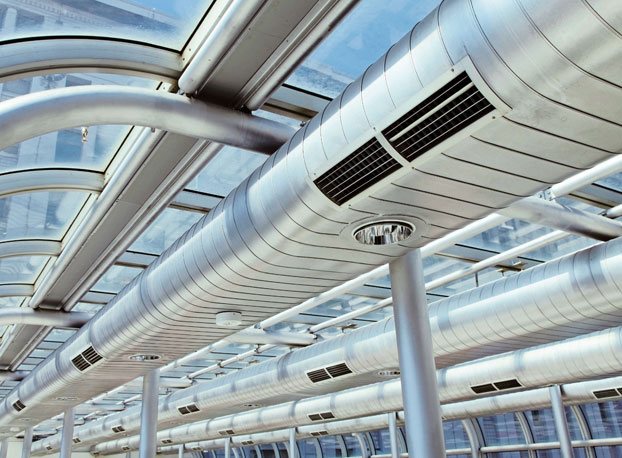

What is hidden under these concepts? The natural motivation is to draw warm air directly from the street (there is such an opportunity even when the outside temperature is below zero). Mechanical impulse takes cold air, heats it up to the required temperature and, already in this form, sends it into the building.
Air heating is excellent for heating large buildings, and industrial heating based on an air system is very efficient. In addition, some types of production, for example, chemical, simply do not make it possible to use any other type of heating system.
What air temperature should be from the batteries during the heating season
To conclude an agreement, you must apply with an application to any heat supply organization located in the applicant's city. It is necessary to sign a contract before providing utilities,
but not later than one calendar month from the date of acquisition of the right to use the premises.
Together with the application, the heat supplying organization must be sent:
- Internal passport of the Russian Federation from the applicant.
- Company registration documents - for example, Articles of Association; the documents must indicate the name of the organization, the details of the enterprise, the place of the state. registration and contact details.
- Extract from the USRN on the premises indicating: the address of the building, the total area of the non-residential premises, the type of activity performed in the premises (production / commercial activity).
- A document certifying the applicant's right to act on behalf of the company - a power of attorney or an order to appoint a manager.
- An act from organizations checking the date of sealing the metering device, as well as the schedule for future inspections of metering devices.
Moreover, it is necessary to pay attention to the fact that all copies of documents must be notarized, otherwise the parties will not be able to conclude an agreement. Notarization of documents, in addition to an extract from the USRN (in 2020, obtaining an extract for legal entities costs 350 rubles), is the basis of expenses during the preparation of documents - notaries charge from 1,500 to 7,500 rubles for notarization of all documents, depending on the region and pricing policy notary
Notarization of documents, in addition to an extract from the USRN (in 2018, obtaining an extract for legal entities costs 350 rubles), is the basis of expenses during the preparation of documents - notaries charge from 1,500 to 7,500 rubles for notarization of all documents, depending on the region and pricing policy notary.
Infrared heating
If there is no opportunity to install liquid or air heating, or if these types of systems do not suit the owners of industrial buildings, infrared heaters come to the rescue. The principle of operation is described quite simply: an infrared emitter generates thermal energy directed to a certain area, as a result of which this energy is transferred to objects located in this area.
In general, these installations allow you to create a mini sun in the work area. Infrared heaters are good because they heat only the area they are directed to and do not allow heat to dissipate throughout the room.
When classifying infrared heaters, first of all, the method of their installation is considered:
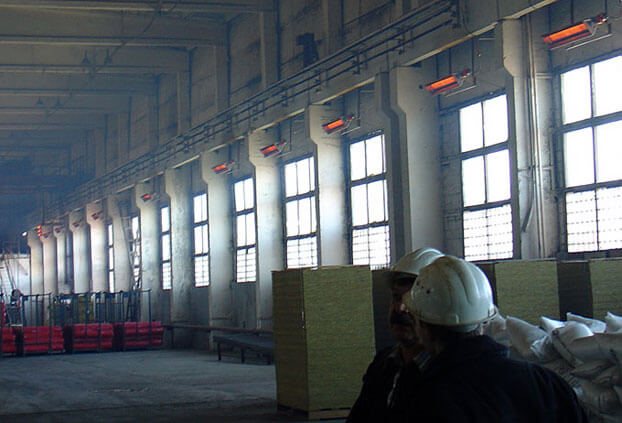

Infrared heaters also differ in the type of emitted waves:
- shortwave;
- medium wave;
- light (such models have a high operating temperature, so they glow during operation;
- longwave;
- dark.
It is possible to divide IR heaters into types according to the energy resources used:
- electrical;
- gas;
- diesel.
IR systems that run on gas or diesel are much more efficient, which makes them much cheaper. But such devices negatively affect the air humidity in the room and burn out oxygen.
There is a classification by type of work item:
- halogen: heating is carried out due to a fragile vacuum tube, which is very easy to disable;
- carbon fiber: the heating element is a carbon fiber hidden in a glass tube, which is also not very durable. Carbon heaters consume about 2-3 times less energy;
- Ten;
- ceramic: heating is carried out by ceramic tiles, which are combined into one system.
Infrared heaters are well suited for use in all types of buildings, from private homes to bulky industrial buildings. The convenience of using such heating lies in the fact that these structures are capable of heating individual zones or areas, which makes them incredibly convenient.
IR heaters affect any objects, but do not affect the air and do not affect the movement of air masses, which eliminates the possibility of drafts and other negative factors that can affect the health of personnel.
In terms of the speed of heating, infrared emitters can be called leaders: they must be launched while at the workplace, and there is almost no need to wait for heat. Such devices are very economical and have a very high efficiency, which allows them to be used as the main heating of production halls. IR heaters are reliable, capable of operating over a long period of time, take up little or no useful space, are lightweight and require no effort to install. In the photo you can see different types of infrared emitters.
This article examined the main types of heating for industrial buildings. Before installing any selected system, it is necessary to calculate the heating of industrial premises. The choice always rests with the owner of the building, and knowledge of the tips and recommendations for calculating the heating of the room will allow you to choose a really suitable option for the heating system.
Types of heating systems by energy source
The energy source can be gas, electricity or solid / liquid fuels.
Gas heating of the warehouse
In gas heating systems, gas air heaters or boilers are used as a heat source. This is a fairly simple and economical heating method, especially if there is a central gas main.Special equipment is also inexpensive, but the device of such heating requires approval from the supervisory authorities and the preparation of a competent wiring project. Each gas boiler must have its own supply pipe and a separate chimney.
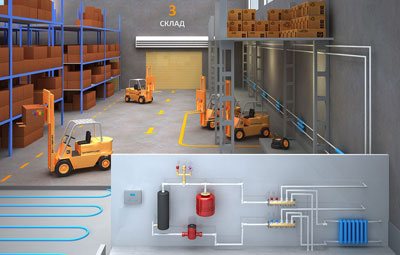

Heating the warehouse with electricity
Here we will not talk about the use of electric boilers. Due to the high cost of electricity, the installation of such equipment is not always economically viable. The operation of electric boilers will be very expensive for owners of large storage areas.
A relatively new method of creating comfortable conditions for warehouse employees is the installation of infrared heat emitters. Special panels are mounted on the ceiling, directly above the workplace. There is a local heating of people, floors, furnishings. At the same time, the air does not heat up and does not circulate. The main advantages of infrared emitters:
- compact placement on the ceiling;
- light weight;
- simple installation.
This heating method is suitable for warehouses of any purpose and area. Infrared panels consume a lot of electricity with constant use, but this is almost half the amount of electric boilers.
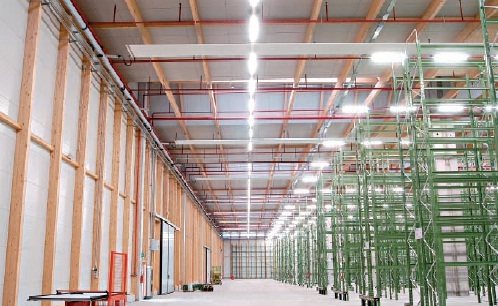

Installation of radiators is justified in cases where it is not possible to arrange water, steam or air heating, for example, in the absence of fuel. The choice of infrared equipment depends on the fire hazard group of the room
Infrared heating of industrial premises
Another way to create good working conditions for workers is through the use of infrared radiation. Devices generate ray energy, which is transferred to surrounding objects, heating them. Then this heat enters the air. The method has a significant disadvantage: uniform energy distribution is not always possible. It can be significantly warmer under the ceiling than at lower levels.
The heating element for infrared heating can be different:
- halogen - if a shock or fall occurs, the tube may break;
- carbon fiber - energy consumption is reduced by almost 2.5 times;
- ceramic - a gas-air mixture burns inside the heater, which is why the device heats up and gives off heat to the environment.
Use regular iron stoves for your home. where you live permanently is not very convenient. There are options that require less time from you.
Every year it is necessary to prepare the boiler room for the heating season. In this case, in winter, problems will definitely not arise.
Do not forget about the ceiling heating system, which is often used to heat industrial buildings. With the help of special devices, not the air is heated, but the walls, ceiling, floor. There is no circulation, therefore, the risk of getting a cold or sore throat for workers in a department or workshop is reduced. A number of advantages are distinguished in the ceiling heating system, such as: long service life, takes up little space, differs in simplicity and speed of installation, and has a low weight.
SNiP standards for heating industrial premises
Before proceeding with the design of a particular system, think about which industrial heating boiler to choose, you need to study the following rules and follow them. It is imperative to take into account the heat loss, because not only the air in the room heats up, but also equipment and objects. The maximum temperature of the coolant (water, steam) is 90 degrees, and the pressure is 1 MPa.
When drawing up a project for heating, staircases are not taken into account. It is allowed to use boilers and other gas-fired equipment only if the oxidation products are removed closed and there is no danger of an explosion or fire in the workplace.
In a multi-storey building, heating risers are replaced by the ZhEK employees.
After the completion of the work, the heating system is filled with water and a control check.
Each of the listed heating methods has its own advantages and disadvantages. It is necessary to choose the best of the methods based on the technological processes that are carried out in a particular workshop. Workers cannot be indoors if the air temperature there is below 10 degrees. Warehouses usually store finished products. To maintain its quality, you need to maintain an optimal microclimate.
Interesting on the topic:
- Preparing the system for the heating season
- Pipes for different heating systems
- Polypropylene pipes for heating: pros and.
- Heating pipe insulation
Central water heating
In the case of a central heating system, heat production will be provided by the local boiler house or by a single system that will be installed in the building. The design of this system includes a boiler, heating devices and a pipeline.
The principle of operation of such a system is as follows: the liquid is heated in a boiler, after which it is carried through pipes to all heating devices. Liquid heating can be one-pipe or two-pipe. In the first case, the temperature is not regulated, and in the case of two-pipe heating, the temperature regime can be adjusted using thermostats and radiators installed in parallel.
The boiler is the central element of the water heating system. It can run on gas, liquid fuel, solid fuel, electricity, or a combination of these types of energy resources. When choosing a boiler, it is first of all necessary to take into account the presence of one or another type of fuel. For example, the possibility of using main gas allows you to immediately connect to this system. At the same time, one must take into account the cost of energy resources: gas reserves are not unlimited, so its price will grow every year. In addition, gas pipelines are very susceptible to accidents that will negatively affect the production process.
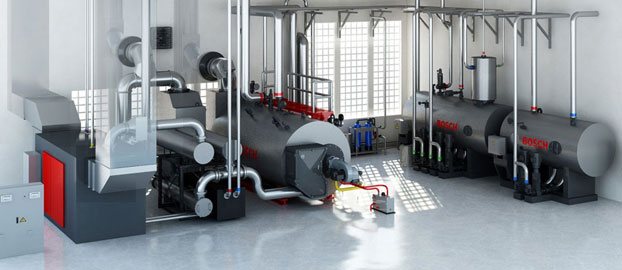

The use of a liquid fuel boiler also has its own "pitfalls": to store liquid fuel, you need to have a separate tank and constantly replenish stocks in it - and this is an additional expense of time, effort and finance. Solid fuel boilers are generally not recommended for heating industrial buildings, unless the building area is small.
True, there are automated options for boilers that are able to independently take fuel, and in this case the temperature is automatically controlled, but the maintenance of such systems cannot be called simple. For different models of solid fuel boilers, different types of raw materials are used: pellets, sawdust or firewood. The positive quality of such structures is the low cost of installation and resources.
Electric heating systems are also poorly suited for heating industrial buildings: despite their high efficiency, these systems use too much energy, which will greatly affect the economic side of the issue. Of course, for heating buildings up to 70 sq.m. electrical systems are fine, but you need to understand that electricity also tends to go out on a regular basis.
But what you really can pay attention to is the combined heating systems. Such designs can have good performance and high reliability. A significant advantage over other types of heating in this case is the ability to provide uninterrupted heating of an industrial building. Of course, the cost of such devices is usually high, but in return you can get a reliable system that will provide the building with heat in any situation.
Combined heating systems usually have several types of burners built in, which allow the use of different types of raw materials.
It is by the type and purpose of the burners that the following structures are classified:
- gas-wood-fired boilers: equipped with two burners, allow not to be afraid of an increase in the price of fuel and malfunctions on the gas supply line;
- gas-diesel boilers: they demonstrate high efficiency and work very well with large areas;
- gas-diesel-wood-burning boilers: extremely reliable and allow you to use them in any situation, but the power and efficiency leave much to be desired;
- gas-diesel-electricity: a very reliable option with good power;
- gas-diesel-firewood-electricity: combines all types of energy resources, allows you to control the fuel consumption in the system, have a wide range of settings and adjustments, suitable in any situation, requires a large area.
The boiler, although it is the main element of the heating system, cannot independently heat the building. Can a water heating system provide the necessary heating of the building? The heat capacity of water is much higher when compared with the level of heat capacity of air.
This suggests that the piping can be much smaller than in the case of air heating, which indicates better efficiency. In addition, the water system makes it possible to control the temperature in the system: for example, by setting the heating at night at 10 degrees Celsius, you can significantly save resources. More accurate figures can be obtained by calculating the heating of industrial premises.
How to transfer a residential object to a non-residential premises
If the owner of an apartment in an apartment building wants to turn it into a non-residential premises, then for this you need to fulfill several conditions:
- a separate entrance is being set up. For premises with an area of more than 100 m 2, an emergency entrance is also made;
- there should be no registered citizens in an apartment changing its status. Before starting the transfer procedure, they are discharged;
- the object should not have any encumbrances. The property must not be mortgaged, mortgaged (not yet repaid), or leased out on a long-term basis;
- the room is located on the ground floor or above other non-residential objects (this was mentioned above);
- no transfer is carried out in buildings in emergency and planned for demolition;
- change of status is made only for the whole apartment. A separate room cannot be turned into a non-residential premises;
- the reason for the ban on obtaining non-residential status may be the finding of an apartment in a building recognized as a cultural and historical monument.
To transfer an apartment in an apartment building to a non-residential premises, you need to collect a package of documents.
All documents with the exception of the application can be submitted as notarized copies. The relevant authority is given 48 working days to make a decision. Receiving a rejection is not yet a final decision. It can be challenged in court.
Selecting a heating option
Only after that you have to choose which type of heating is most suitable. To measure the area of the basement, as well as temperature fluctuations, you will need:
- roulette;
- pencil;
- note paper;
- thermometer;
- barometer.
Temperature and humidity readings should be recorded over several days to determine which one is right for you. After that, analyze the indicators that will show you what humidity is in the basement, how much heat is required for heating. There is equipment that not only heats, but also dries the air, or vice versa, humidifies it. In addition, you will have to take into account the structure of the foundation of the room, repairs in the room, the presence of doors and windows.
It is also important how the basement is isolated from general communications. If there is a possibility of a tie-in to the general heating, remember that there may be problems with calculating the payment, since it is not always possible to calculate the correct numbers. However, there are options where individual heating is not suitable for your particular basement.
Advantages and disadvantages of electric heaters
Many people cannot get enough of infrared heaters due to their striking advantages:
- ideal for work in dusty and dirty rooms, as well as for buildings with an increased level of fire hazard;
- the possibility of using not only as a general and partial heating system, but also as special equipment for drying;
- a spot heater is used in paint and varnish industries, for heating steel before processing, for arranging a floor anti-icing system;
- electric heaters are actively used in educational and medical institutions.
Recommended: Features of infrared plasterboard heating
The downside is the high price for electricity. You can slightly reduce heating costs by installing industrial temperature sensors.
Gas or electricity
It is recommended to use the mains voltage in the basement not higher than 42 V.
So, an important factor in determining which basement heating you choose will be the purpose of the room. If you plan to equip a living space in the basement, you will need full heating to keep it warm even in the worst frosts. Options for steam heating and a gas boiler will be relevant here, if the design provides for it. If the ventilation is broken at the basement, then first you need to finish it, plaster all the cracks from which air can come from the outside.
If you are planning an office plan or a store, you can opt for a heating system on radiators that work from the electrical network and are capable of heating rooms with a fairly large area. Such heating in the basement will also dry the air, so it is ideal for rooms with high humidity.
But with this choice of heating, you should pay attention to the power of the electrical network, where the radiator will be connected. If the office will be heated, where there are already so many electrical appliances and electronics, such a voltage will not be able to withstand the network and it will become necessary to install additional equipment, which will incur certain costs in addition to paying for electricity
If the humidity in the basement exceeds the permissible standards, then in addition to heating, you should also worry about drying the air, since moisture destroys the basement as a whole and negatively affects the quality of the air you will breathe. So on the basement floor it will turn out to equip comfortable conditions.
If you have plans to store something in the basement, use it as a warehouse, and the relatively low temperature does not interfere with storage, you can use an ordinary battery, moreover, its installation will not require special changes in the design of heating throughout the house.
Infrared heating is an alternative to boilers and radiators. This option has several advantages: short-term installation work, ease of equipment installation. You can equip it quickly, conveniently, simply and efficiently.
In any case, when installing any heating, you first need to consult with certain responsible services. You can only install a heater in the basement on your own; in all other cases, you will need the help of specialists, professionals in their field. Calculations that will be associated with the installation of heating in the basement are also best left to professionals.
The question of the material for the equipment is also important. From what material is it better to choose the pipes to be installed, which batteries are best to choose, or what type of radiator will be of better quality? All these are individual parameters for each specific basement, and only correct calculations and observations of air and humidity can show this.
Peter Kravets
Reading time: 4 minutes
A A
Basement heating is of interest to both owners of multi-storey buildings and private country cottages. Often they are equipped with bars, billiard rooms, cafes, recreation areas, gyms, saunas or small cinemas.
IR gas heaters
It should be noted right away that this type of fuel for IR heaters has a lot of advantages, which are just what many potential buyers appreciate. The first and foremost of them is the efficiency of the device in use.
You can compare it with any other type of heating, and you can immediately see that the fuel costs in an infrared heater are about 70% less. In fact, if you use an industrial IR heating system, then this system will be able to pay off in the next couple of seasons.
Types of gas heaters
To begin with, be sure to single out the heaters into two groups. It will be the infrared ceiling heaters intended for production sites that will be divided:
- Light emitters. These devices are specially designed to heat factories where ceilings are more than 4 meters high. At the moment, these are one of the most demanded devices in industrial production. According to calculations, approximately for every 20 - 25 meters, 1 installation with a capacity of 1 kW will be needed. If it is necessary to warm up about 100 cubic meters, then hanging heaters with a power of 5 kW are used. During their operation, the combustion products, which are extremely harmful to health, will be eliminated by the gas outlet.
- Dark type of emitters. In this type of systems, gas begins to be absorbed only at a temperature of no more than 400 degrees. Due to this, the metal tube will not get red-hot during operation, from which this name of the emitters actually appeared. Before you start installing such heaters, it is worth considering that they are not quite small, unlike light emitters. But for factories and other industrial facilities, both types of emitters are purchased. The choice remains only with the buyer.
Advantages of gas emitters
For an industrial type of gas emitter, a number of specific advantages can be distinguished that are clearly to the liking of many buyers:
- there is an opportunity for the enterprise to heat the premises locally;
- rather low heat costs;
- the device will pay off literally in 2 - 3 years;
- no need to spend money on staff who will serve;
- can be turned on at any convenient time of the year;
- extremely fast warming up of a large cold zone.
The only caveat is that this type of heater is not particularly suitable for home use. Therefore, it is called industrial. In order to use it, you need ceilings not lower than 3-4 meters. If the height is less than 3 meters, then the use of the emitter is dangerous.
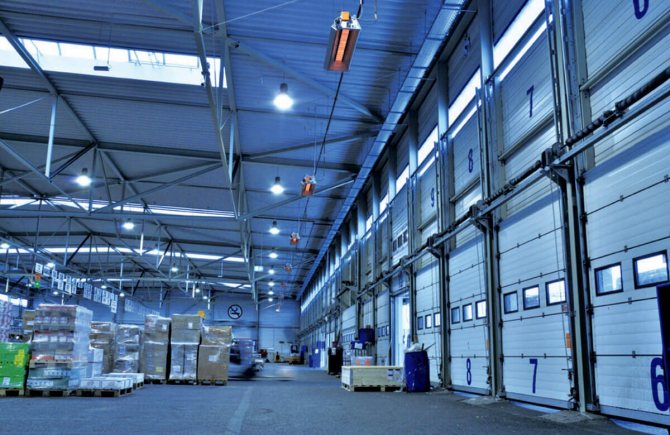

Basement ventilation
The basement of a multi-storey building serves as the main source of the ventilation system. Since there is a ventilation duct on each riser of any floor, which ensures the normal circulation of air masses in the apartment. There are ventilation outlets in the apartment in the kitchen and sanitary area.
Sometimes special hoods are placed on them, which help to draw out unpleasant odors. Also, the normal functioning of the ventilation ducts that come from the basement ensures gas escape in the event of a leak for domestic reasons. Therefore, verification of such a system is very often carried out by experienced specialists of the relevant service.
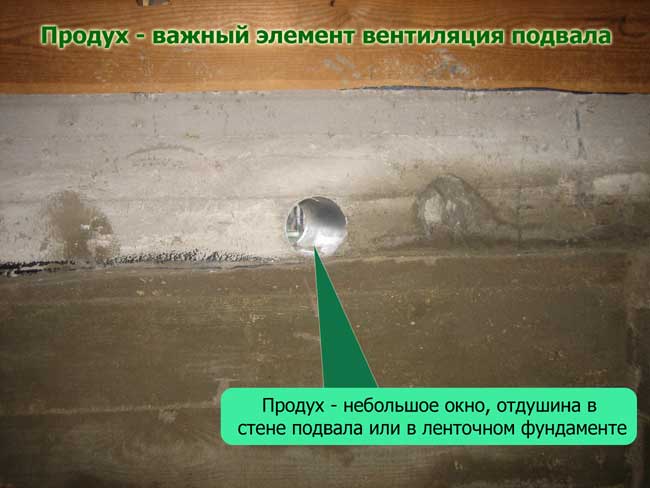

The ventilation ducts in the basement provide not only the function of extracting unpleasant odors, which can form as a result of dampness or fungal diseases on the walls of the basement. They still provide such rooms with fresh air to a large extent, which is also necessary for a longer period of operation. There are two types of ventilation in the basement: natural and artificial.
Heating industrial premises: selection and comparison of heating systems
Selecting and comparing industrial heating systems before purchasing and installing is an important step.This process is quite laborious and problematic.
The reasons for this are as follows:
- Correct accounting and ratio of cost, functionality and reliability.
- The need for special equipment for large areas from 50 sq.m.
Industrial heating in terms of equipment has certain criteria:
- There should be maximum space savings. Moreover, if the installation is supposed to be on the ceiling or walls.
- Possibility to switch to economy mode.
- The possibility of heating separate areas of a large industrial room.
- Ease of installation, as well as ease of dismantling if the equipment needs to be moved to another location.
- There must be a large amount of air blown through, which will allow the industrial room to warm up evenly.
- Adequate heating costs for industrial plants.
Electric heating
Electric industrial heating has a number of its features:
- Automated work on heating, which allows to generate efficiency up to 99%.
- It can be used as a source of hot water supply.
- The indoor air remains clean.
Benefits:
- Rapid deployment of the heating system
- It is possible to maintain the optimum temperature in the building through regulation.
- There is a choice of devices at the best price and configuration
Disadvantages:
- Not all premises have a high power supply.
- The high temperature of the heating elements reduces the oxygen level in the room.
- Not recommended for use in rooms with high humidity.
Electric heat guns
They help to quickly heat the air in the room and lower the humidity level in it. Large heat guns from 380 volts are used on an industrial scale. The device consists of three main elements:
- fan;
- Control block;
- TEN (directly heater).
Principle of operation:
- after connecting to the mains, the blades begin to rotate;
- the pressure around the heater becomes low;
- through special holes, air enters the inside of the device into the heat exchanger;
- the air heats up and leaves the housing under pressure.
Pros:
- suitable for hangars, workshops, warehouses;
- you can quickly warm up frozen equipment;
- dry the room well;
- mobility;
- easy to manage;
- situations of equipment overheating rarely occur.
Minuses:
- under normal conditions, the air is very dry.
- with high warm ceilings, the air goes up;
- high noise level;
- large models are heavy.
The power can be calculated based on the manual of the manufacturer of the electric gun. However, there is also a formula that looks like this: ((S x h) / 30) x K = P kW
In it:
- S is the area of the room;
- h is the height of the ceilings;
- K is a coefficient indicating the degree of insulation of the room:
- if it is unknown, use "1" by default,
- if the thin walls of hangars and other weakly insulated structures are "1.5", if the room temperature is enough -15, we use the coefficient "0.5"
Electric heat gun BALLU BHP-ME-5
Easy to use in the Russian climate, there is an anti-vandal coating, can be used without heating, there are 2 power levels, built-in thermostat, up to 50 sq.m.
Pros: lightweight, compact, vandal-proof, does not corrode Cons: cannot be plugged into a standard outlet.
Electric heat gun BALLU BHP-M-36 MASTER
Suitable for premises that are undergoing renovation or those that are under construction, as well as any industrial facilities, it withstands harsh Russian conditions well, up to 350 sq.m.
Pros: Can be used as a fan in summer, suitable for large areas, stable frame, accurate temperatures. Cons: Powerful wiring required.
Electric heat gun BALLU BHP-M-24 MASTER
Up to 240 sq.m. - coverage of the area, there is an anti-vandal coating, an excellent solution for heating production facilities, you can adjust the power.Pros: there is a manual restart, large heating area, quickly raises the temperature. Cons: possible overheating, no plug on the body.
Electric air curtains
Electric thermal curtains create a flat and powerful air flow. Their main function is to create an obstacle curtain for the penetration of cold air masses into the room. This is the main feature of air curtains. Principle of operation:
- powerful directional air flow exits from the rectangular slot;
- a strong flow creates a built-in fan;
- there is a heating element that makes the air warm.
Pros:
- works almost silently;
- excellent protection of the room from the penetration of cold air into it;
- a microclimate favorable for humans is created.
Minuses:
- installation complexity, professionals are needed for installation;
- high electricity costs.
Electric thermal curtain TEPLOMASH KEV-6P2211E
Thermal curtain in a robust stainless steel case, designed for vestibules and entrance groups, control: wired and remote, for rooms up to 60 sq. M. Pros: copes well with its purpose, nice design, affordable price Cons: not found.
Electric thermal curtain TEPLOMASH KEV-12P3041E
For doorways up to 3.5 m, high degree of corrosion protection, used as an auxiliary heating source, suitable for rooms up to 120 sq. M. Pros: convenient control mode, including remote control. Cons: not identified.
Electric thermal curtain TEPLOMASH KEV-36P4021E
Suitable for a warehouse and other areas up to 120 sq.m., ribbed electric heating elements are used, has a low vibration level. Pros: reliable model, affordable price, there is a control panel. Cons: no.
Electric fan heaters
They are good because they can be used all year round. In the summer they can work to cool the air. They are widely used in production, warehouses, greenhouses, garages, hangars, etc. The principle of operation is quite simple, since fan heaters do not have a complex design: motor, fan, control unit, housing, adjustable blinds.
Pros:
- easy to operate;
- there are mobile and stationary devices to choose from;
- no need to control the fuel level;
- many models can work around the clock.
Minuses:
- spirals fail prematurely.
Electric fan heater TEPLOMASH KEV-15S40E
In a short period of time it heats up a large area, it is good for construction, including an area of 150 sq.m., it consumes little electricity. Pros: compact, quiet, there is a thermal relay, fast heating. Cons: not identified.
Electric fan heater TEPLOMASH KEV-35T20E
Inside the high-quality case there is a stainless steel heating element, warm air comes out through a protective grill, there is a thermostat with the ability to set from +5 to +40 degrees Celsius. Pros: reliable, long service life, area coverage up to 350 sq.m., reasonable cost. Cons: not found.
Electric fan heater TEPLOMASH KEV-100T20E
The body is made of high-quality polymer coating, air heating up to +40 degrees Celsius, suitable for rooms up to 350 sq.m. Pros: affordable price, mobility, fast air heating, there is a thermostat on the body. Cons: not found.
Electric boilers
This equipment is intended for heating and hot water supply of large facilities, most often agricultural and industrial. Electric boilers operate on the principle of reheating the coolant. At the same time, the water heats up to +130 degrees. Celsius to generate steam. Further, the steam enters a special collector, where the liquid settles. The resulting dry steam is reheated. Under pressure, such steam is released outside, heating the area. Pros:
- silent work;
- economical equipment;
- an electronic control unit is provided;
- guarantee of constant room temperature;
- autonomous provision of hot water is possible.
Minuses:
- high price;
- high power transmission lines are needed.
Electric boiler Evan EPO - 36
The boiler can be used as the main or backup heating of premises, made of stainless steel, heating up to 350 sq.m., reliable thermal insulation. There is a self-diagnosis system. Pros: there is an emergency thermal switch, compact size, high efficiency Cons: high cost.
Electric boiler Evan EPO - 72
High-quality professional boiler for rooms up to 720 sq.m., heating elements are made of stainless steel, there are automatic and manual operating modes. Pros: long service life, compact size, high efficiency. Cons: high cost.
Electric boiler Evan EPO - 216
Single body with anti-corrosion coating, digital display of the control system, programmable thermostat, certified anti-freeze liquid can be used. Pros: long service life, compact size, high efficiency, there is a self-diagnosis system, for rooms up to 2200 sq. M. Cons: high cost.
Gas heating
This type of heating requires a connection to a centralized main gas. The equipment has:
- gas burners that supply gas;
- high quality copper heat exchanger;
- pump for water supply;
- manometer and thermometer;
- tank;
- built-in security system.
Pros:
- inexpensive type of industrial heating;
- suitable for most premises: warehouses, workshops, landfills, etc.;
- heating can be regulated;
- you can set the heat supply mode.
Minuses:
- the equipment has a complex structure, which requires careful control;
- to avoid emergencies, the equipment needs constant maintenance;
- complex installation system.
Usually the manufacturer of the equipment indicates the area of heating of the room. But there is also a formula for calculating thermal power: ((S x h) / 30) x K = P kW.
Gas heat guns
Gas heat gun TEPLOMASH AT95H
Serves for direct horizontal supply of thermal air, there is an axial fan, heating up to 920 sq.m., equipped with a thermostat, there is a louvered grill. Pros: powerful equipment, can be used constantly. Cons: not identified.
Gas heat gun NEOCLIMA NPG-80
Work on propane-butane, there is protection against overheating, directed flow of heated air, designed for heating an area of up to 800 sq. M. Pros: fast air heating, high power, low cost of equipment. Cons: mechanical control.
Gas heat gun BALLU BHG-60
Designed for an area of up to 570 square meters, equipped with a galvanized steel combustion chamber, constant air ventilation. Pros: smokeless combustion of fuel, high level of efficiency, instant operational status, low cost. Cons: not identified.
Gas thermal curtains
Gas thermal curtain TEPLOMASH KEV-75P7030G
Protects doorways from the penetration of cold air into the room, can be installed horizontally or from the side, the temperature of the gases inside reaches up to 400 degrees Celsius. Pros: Suitable for large industrial facilities. Cons: not found.
Gas thermal curtain TEPLOMASH KEV-100P7040G
With this curtain, the doorways of industrial premises will be well protected from cold air masses, seamless pipes are used in the construction, the wall thickness of the heat exchanger is 2 mm. Pros: use for large areas of production facilities. Cons: not identified.
Gas thermal curtain TEPLOMASH KEV-55P416G
Can be installed horizontally above the doorway or vertically on the side, the heat exchangers are aluminum-coated inside and outside, the construction uses seamless pipes. Pros: excellent protection of doorways from the cold air of large rooms. Cons: not found.
Gas fan heaters
Gas fan heater GU-60
It is used for areas up to 60 sq.m., for air heating of industrial premises, direct horizontal supply of warm air. Pros: the set includes a control panel, as well as a mounting console for outdoor installation, lower cost, quick achievement of the selected temperature. Cons: high cost.
Gas fan heater GREERS GP1-60
There is an axial fan and a louver grille that can be adjusted in two directions, direct horizontal supply of warm air. Pros: you can use the remote control for control, saving on heating. Cons: high cost of equipment.
Gas fan heater GREERS GP1-31
Energy efficiency 92%, three-stage safety system, closed combustion chamber, advanced heat exchanger. Pros: Comes with a remote control, high power. Cons: only for an area of 30 sq.m.
Gas boilers
Gas boiler Baxi LUNA Duo-tec MP 1.99
Condensing type of work, placed on the wall, using natural gas, a closed combustion chamber, digital indexing of temperature and pressure. Pros: high power, compact size, the ability to cascade up to 16 stakes, built-in weather-dependent automation. Cons: not found.
Gas boiler Buderus Logano G334-146 WS
Popular floor standing boiler of premium class, designed up to 1000 sq.m., meets all standards, silent operation of the system.
Pros: reliable, powerful unit, there is a protective flap. Cons: not found.
Gas boiler Protherm Grizzly 150 KLO
Injection burner, seasonal operation, self-diagnostics, the display contains information from various sensors, it is possible to connect to a cascade. Pros: affordable price, reliable equipment. Cons: no built-in hot water heating.
Water heating
Water heating is suitable for large industrial premises. The source can be central heating or your own boiler room. The principle of operation is that through pipelines water enters the heating devices. Typically in production, these are radiators and water heaters. Positive points:
- increased efficiency, since the heated air is evenly distributed;
- this heating system can be connected to ventilation and air conditioning;
- inexpensive installation cost.
Minuses:
- it is necessary to organize a heat point additionally.
Water heaters
Water heater TEPLOMASH KEV-60M5W1 MW SERIES
Effective in industrial and industrial environments, has a powerful 3-speed fan, and requires a special mounting bracket that swivels in different directions. Pros: there is a wired and remote control, to which you can connect up to 3 such devices, low cost. Cons: heavy.
Water fan heater VOLCANO VR2 AC
A popular and demanded model for heating industrial and industrial premises, as well as sports facilities, greenhouses, greenhouses, supermarkets, a dual-core heat exchanger, an improved axial fan helps to direct air up to 25 m.Pros: it uses energy economically, with the help of blinds, you can direct the air flow. Cons: not identified.
Water fan heater VOLCANO MINI AC
Suitable for garages, greenhouses and other industrial premises, efficient equipment for air heating. Pros: 5-year warranty, price-quality ratio, lightweight, compact, economical. Cons: not identified.
Water radiators registers
Radiator aluminum Rifar Alum 500 × 10
Wall-mounted sectional, aluminum housing, side connection, heats up to 135 degrees Celsius. Pros: high-quality reliable product, low cost. Cons: not found.
Sectional bimetallic radiator Rifar SUPReMO 500
Wall-mounted with side connection, bimetallic housing, maximum heating up to 135 degrees Celsius. Pros: reliable high-quality unit, affordable price.Cons: no mounting kit.
Sectional bimetallic radiator Rifar Base 500
Description: sectional, wall-mounted with side fastening, center distance - 500 mm, heating up to 135 degrees Celsius. Pros: good heat dissipation, beautiful, affordable price, reliable manufacturer. Cons: not found.
Heat guns
An efficient heater with high performance. The principle of operation is the same as for fan heaters. The fan is built-in for forced circulation of air masses. Usually the body is made of metal. And the installation is carried out on the floor. Pros:
- durable;
- able to work for a long period of time;
- portable, so they can be installed anywhere.
- easy to operate and maintain.
Minuses:
- after shutdown, the room temperature drops rapidly;
- very noisy.
Usually manufacturers indicate in the instructions what area the gun is designed for. However, you can independently find out by the formula that was indicated above.
Diesel cannons
Diesel heat gun BALLU BHDР-20
Designed for 200 square meters, high level of efficiency, there is an air purification filter, a built-in fuel level sensor, a multi-level security system is provided, they run on diesel fuel, are intended for industrial premises. Pros: Reliable, economical, affordable. Cons: Depends on the power supply, requires an extension cord.
Diesel heat gun MASTER B 180 DIRECT HEATING
Designed for an area of up to 480 square meters, there are two fuel filters, equipped with a trolley for transportation, electronic flame stabilization system. Pros: reliable, low cost, well-known manufacturer. Cons: not found.
Diesel heat gun MASTER BV 470 FS INDIRECT HEATING
For areas up to 1340 sq.m., axial fan, there is a thermostat for protection against overheating, there is a summer and winter mode of operation, there is a trolley for transportation, 2 fuel filters. Pros: economical, designed for a large area, reliable, well-known manufacturer. Cons: not found.
Diesel or gas heat gun
Equipment comparison:
- With diesel heat guns, the scope of application is limited, since the fuel is supplied by a pump or compressor. In this case, it is necessary to constantly ventilate the room so that the combustion products leave the room. A gas cannon is more environmentally friendly equipment, since there are practically no combustion products.
- For gas heat guns, the efficiency is almost 100%.
- Unlike diesel ones, gas heat guns are more economical.
- All devices are easy to operate.
To make the right choice, you need to decide for which room they will be used, what technical characteristics are in the building.
Heat guns or fan heaters
Equipment comparison:
- The functional load of the fan heater on average ranges from 1 to 2 kW / h, the heat gun - more than 4 kW / h. Thus, the heat gun is more suitable for large production areas.
- The fan heater is always tied to the network, and heat guns can operate both on gas and on fuel autonomously.
- Both heat guns and heating fans have rollover protection, which reduces the risk of fires.
When choosing, you also need to focus on the area for heating, the presence of an electrical network, the duration of the devices.
Infrared heating
The main feature is minimal power consumption as well as high efficiency. The principle of operation is rather complicated, but it boils down to the fact that objects from the device warm up and transfer heat to the surrounding air only in the working area of the IR heater. There is no need to warm up the entire large room, only the working area. Pros:
- the room heats up quickly;
- withstand voltage surges;
- does not dry out the air;
- ease of installation.
Minuses:
- such a system requires preliminary design and competent distribution in an industrial building.
Infrared heater DUET 2,0 kW
A closed heating element is used, has a capacity of 2.0 kW, heats up to 20 sq.m., suitable for cafes, restaurants and shops. Pros: Reliable, affordable price. Cons: not found.
Infrared heater BALLU BIH-S-0.3
Double insulation is used as the main heat source for 3 sq.m. and additional up to 6 sq.m., there is overheating protection. Pros: reliable, inexpensive, suitable for armstrong ceilings. Cons: not found.
Infrared heater FRICO EZ115N
As the main heat source for 7 sq.m. and additional - up to 15 sq.m., maximum surface temperature up to 280 sq.m., it is possible to mount to the ceiling. Pros: very reliable, well-known brand. Cons: not identified.
Industrial boilers
Industrial boilers differ from each other in the type of fuel that is used. For example, they can be solid fuel and diesel. However, both are suitable for industrial and industrial premises, hangars and garages. Pros:
- fuel availability;
- autonomous work;
- high efficiency.
Minuses:
- constant maintenance is necessary;
- diesel fuel may smell;
- some models are quite expensive.
Solid fuel boilers
Solid fuel boiler Protherm Bober 50 DLO
Firewood or coal are used, power 39 kW, independent of the power grid, single-circuit, efficiency is 92%, installed on the floor, open combustion chamber. Pros: Affordable price, reliable performance. Cons: the bottom is heated.
Solid fuel boiler Buderus Logano S111-2-45D
The classic type of solid fuel boiler, power 45 kW, efficiency 82%, uses coal, coal briquettes, firewood, wood briquettes, coke, open combustion chamber, floor installation. Pros: reliable unit, reasonable cost. Cons: not found.
Solid fuel boiler Protherm Bober 60 DLO
Power 48 kW, non-volatile, firewood and coal are used as fuel, efficiency is 90%, installation on the floor, open combustion chamber. Pros: pleasant price, reliable performance. Cons: not found.
Diesel boilers
Oil fuel boiler Kiturami TURBO HI FIN 30
Power 34.9 kW, operation on diesel fuel, efficiency 87%, floor-mounted, double-circuit. Pros: does its job well. Cons: suitable for single phase network.
Liquid fuel boiler Viessmann Vitorondens 200-T BR2A035
Floor-standing installation, suitable for a single-phase network, power 42.8 kW, liquid fuel condensing, diesel is used. Pros: Efficiency 103%. Cons: not found.
Combined boiler Protherm Bizon 40 NL
The boiler is of a combined type, power is 38 kW, diesel and gas are used as fuel, efficiency is 89%, floor-standing installation, open combustion chamber, single-circuit. Pros: high efficiency, reliability. Cons: not found.

